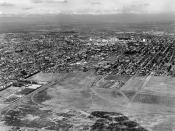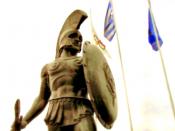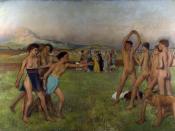"The Spartan life was Spartan indeed" At first examination of Spartan life it may seem quite sparse. Upon a more detailed examination of Spartan life Sparta is found to have a very rich religious and cultural life, serfs to attend to menial tasks and in theory a democratic government.
Sparta was made up of three main social groups. At the top of the group was the Spartans that were a society that was almost entirely geared for war. Below the Spartiates (or Spartans) were the Perioikoi, or "dwellers around or about." The Perioikoi were foreign people who served as a kind of buffer population between the Spartans and the helots. Because of this vital function, they were accorded a great deal of freedom. Most of the trade and commerce carried out in Sparta were performed by the perioikoi. At the bottom were the helots.
The Messenians were turned into agricultural slaves called helots.
Their lives are best described as the life of a serf. They worked small plots of land on estates owned by Spartans, Large part of their produce went to the master of the estate and the barracks, and the remainder went to the helot farmer and his family , Tyrtaeus (Spartan poet) compared helots to "asses exhausted under great loads: under painful necessity to bring their masters full half the fruit their ploughed land produced." There is no question that the life of the helots was a miserable life. Labour was long and hard and the helots always lived right on the border of subsistence. "The Spartans believed themselves to be superior to the helots and showed no hesitation in exploiting them in order to maintain their own unique lifestyle"
Spartiates no longer had to worry about money; this economic independence freed the Spartiates to concentrate all...


